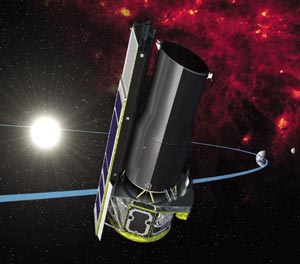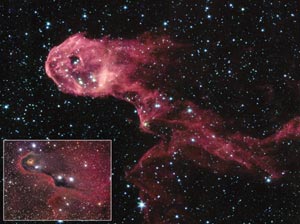
On 18 December 2003 a new window to the universe opened with the release of the first dazzling images from NASA’s newly named Spitzer Space Telescope, formerly known as the Space InfraRed Telescope Facility. The telescope was renamed after Lyman Spitzer (1914-1997), a renowned astrophysicist who first proposed placing telescopes in space in the mid-1940s.
The Spitzer Space Telescope was launched by a Delta II rocket from Cape Canaveral, Florida, on 25 August 2003. It is the fourth and last mission of NASA’s suite of Great Observatories, which includes the Hubble Space Telescope, the Compton Gamma-Ray Observatory and the Chandra X-ray Observatory. Consisting of a 0.85 m telescope and three cryogenically cooled science instruments, Spitzer is larger than the 0.6 m European Infrared Space Observatory, which was in operation from November 1995 until May 1998.
The Spitzer Space Telescope is devoted to observing infrared radiation at wavelengths between 3 and 180 µm. This is mainly heat emission from celestial bodies that have a temperature between roughly 10 and 1000 K. Such objects include small stars that are too dim to be detected by their visible light, extrasolar planets and giant molecular clouds. However, infrared radiation also has the advantage over visible light of being able to penetrate the dense clouds of gas and dust that block our view. Spitzer therefore allows us to peer into regions of star formation, the centres of galaxies and into newly forming planetary systems, which are hidden from optical telescopes. Its spectral capabilities can detect the unique signatures of the many molecules in space, including those that are organic.
Because infrared is primarily heat radiation, the telescope must be cooled to near absolute zero so that it can observe infrared signals from space without interference from the telescope’s own heat. To reduce the amount of cryogen used to cool the instruments as much as possible, the spacecraft is protected by a solar shield, while its innovative Earth-trailing heliocentric orbit keeps it away from the heat released by our planet.
After the two-and-a-half-year Spitzer mission, the next infrared space telescope will be European. The Herschel mission of the European Space Agency, formerly called the Far InfraRed and Submillimetre Telescope, is scheduled for launch in February 2007. With a mirror of 3.5 m it will detect much fainter sources than Spitzer but at longer (80 to 670 µm) wavelengths, so covering the full far-infrared and submillimetre waveband.
Picture of the month

One of the very first images from the Spitzer Space Telescope provides a spectacular contrast to the opaque cloud seen in visible light (inset, bottom left). Spitzer has transformed this dark globule – known as the Elephant’s Trunk – within the emission nebula IC 1396 into a glowing stellar nursery that resembles a creature on the run with flames streaming behind it. Spitzer’s infrared detectors unveiled the brilliant hidden interior of this opaque cloud of gas and dust, exposing for the first time young stars being formed in the densest parts of the cloud. The image is a four-colour composite of infrared light, showing emission from wavelengths of 3.6 µm (blue), 4.5 µm (green), 5.8 µm (orange) and 8.0 µm (red). (NASA/ JPL-Caltech/W Reach (SSC/Caltech).)








